
In General
Map
Pictures
TGV by Generations
Floobydust
RAILROAD SIGNALS HOME
Location / Name:
France
What's Here:
High Speed Trains
Data:
GPS Coordinates: as needed
Phone: n/a
ZIP: n/a
Access by train/transit:
All over the place! :-)
The Scoop:
When Americans think of High Speed Train Service, we "usually" think of the Acela service on the Northeast Corridor. When Americans mention "our" high speed service to friends that have access to real high speed service, the friends usually laugh :-) The fastest I have seen trains go on the NEC is about 125mph, in a very short section of tracks in northern New Jersey.
PS: You'll notice at the top of the page I have "introduction to", instead of my usual "railfan guide to". This is because no one page can do either the SNCF or the TGV justice, there are just too many locations, specifics and details to be covered with only one page. For more detail, I suggest starting out with some of the pages I have come across below in my "for more info section".
SNCF's High-Speed Service: The TGV
The SNCF operates a system of high speed intercity trains, called the TGV, or Train à Grande Vitesse (high-speed train). The TGV opened to the public between Paris and Lyon on 27SEP1981. The TGV was the world's third commercial standard gauge high-speed train service, after Japan's Shinkansen, which connected Tokyo and Osaka on 1OCT1964, and Britain's InterCity 125 on main lines such as the East Coast Main Line, which entered service in 1976.
The TGV system itself extends to neighbouring countries, either directly (Italy, Spain, Belgium, Luxembourg and Germany) or through TGV-derivative networks linking France to Switzerland (Lyria), to Belgium, Germany and the Netherlands (Thalys), as well as to the United Kingdom (Eurostar). Several future lines are planned, including extensions within France and to surrounding countries. Cities such as Tours and Le Mans have become part of a "TGV commuter belt" around Paris; the TGV also serves Charles de Gaulle Airport and Lyon–Saint-Exupéry Airport. A visitor attraction in itself, it stops at Disneyland Paris and in tourist cities such as Avignon and Aix-en-Provence as well. Brest, Chambéry, Nice, Toulouse and Biarritz are reachable by TGVs running on a mix of LGVs and modernized lines.
Rebranding: Since July 2017, TGV services are gradually being rebranded as TGV inOui and Ouigo in preparation for the opening of the French HSR market to competition. TGV inOui is SNCF's premium high-speed rail service. The name inOui was chosen because it sounds like the French word inouï meaning “extraordinary” (or more literally, “unheard of”). Ouigo is SNCF's low-cost high-speed rail service. Trains have a high-density one-class configuration and reduced on-board services. The services traditionally operate from less busy secondary stations, sometimes outside of the city centre. The literal translation of the brand name is “yes go,” but the name is also a play on the English homonym, “we go.”
A modified TGV test train holds the world speed record for conventional trains. On 3 April 2007 a modified TGV POS train reached 574.8 km/h (357.2 mph) under test conditions on the LGV Est between Paris and Strasbourg. The line voltage was boosted to 31 kV, and extra ballast was tamped onto the track bed. The train beat the 1990 world speed record of 515.3 km/h (320.2 mph), set by a similarly shortened train (two power cars and three passenger cars), along with unofficial records set during weeks preceding the official record run. The test was part of an extensive research program by Alstom.
Back in 2002, I had the opportunity to go to France on business for three weeks. One of my most memorable moments, was as I was traveling "up" the A7 on a return trip from Aix en Provence to Grenoble. One of the SNCF's lines ran just off to my right. I'm cruising along about 70 (mph) or so, and noticed a bright headlight in my rear view mirror. I'm on a slight upgrade going over one of the many hills south of Lyon. The headlight was from a TGV train. The train whooshes past me. By the time I got to the crest of the hill, which was only 20 seconds or so, I couldn't see the train anymore - that thing was humpin and left me in the dust!!! Back then, Aix did not have TGV service, today it does - I also remember passing by a construction site for the high-speed line heading to Marseilles.
Acknowledgements:
Daniel Simon
Wikipedia
Open Railway Map
Google Maps
Websites and other additional information sources of interest on the TGV:
https://www.sncf.com/fr
https://www.sncf.com/en
https://en.wikipedia.org/wiki/SNCF
https://en.wikipedia.org/wiki/TGV
https://www.seat61.com/trains-and-routes/tgv.htm
https://en.wikipedia.org/wiki/SNCF_TGV_Sud-Est
https://www.railteam.eu/en/high-speed-travel/high-speed-trains/tgv-lyria/
Maps
A couple of maps of the TGV service in France:
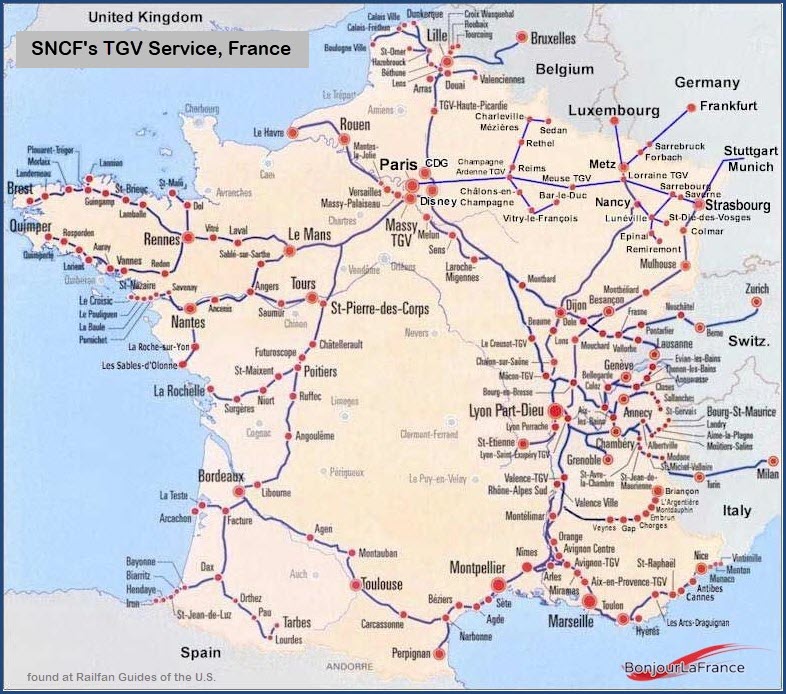
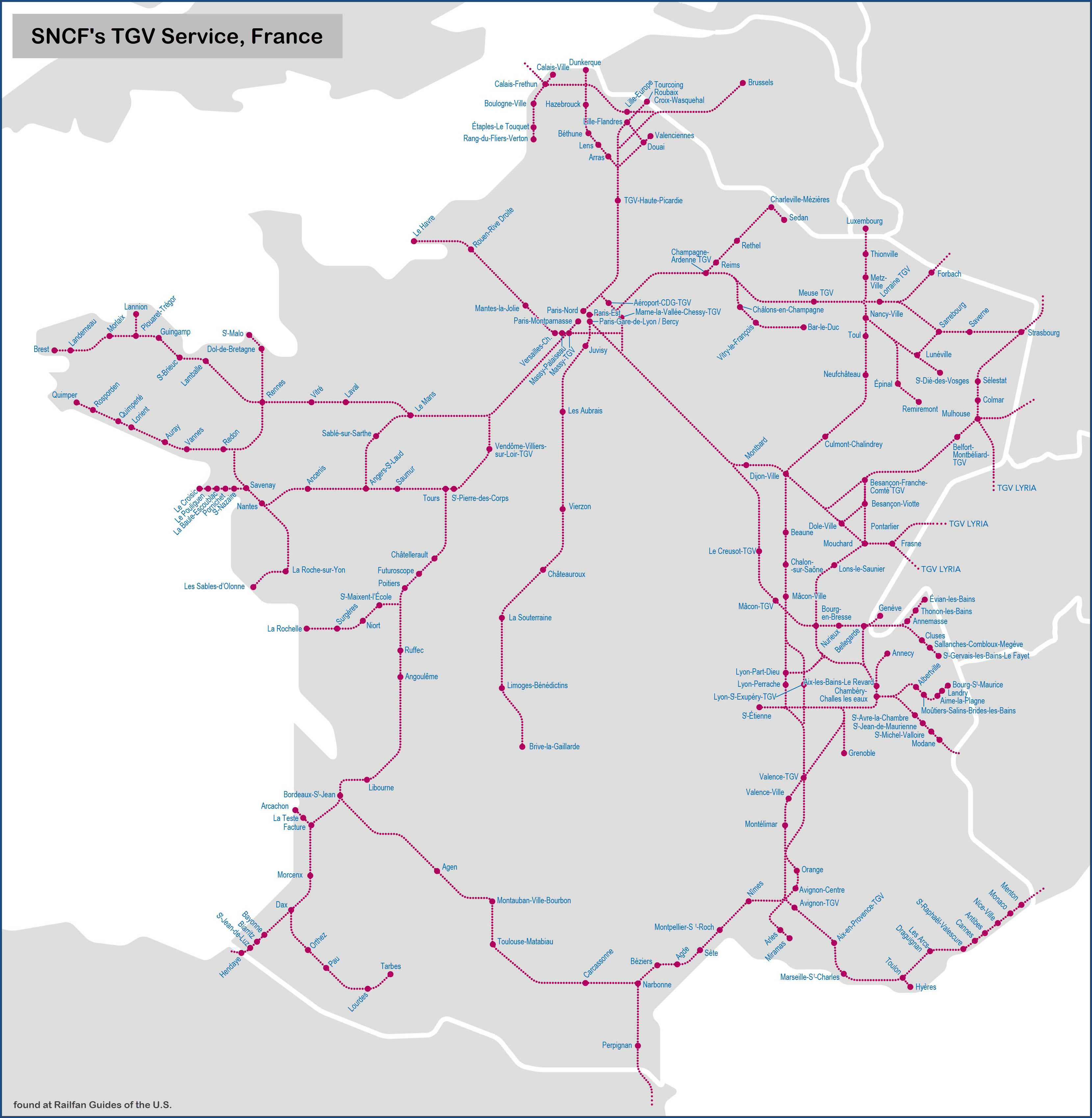
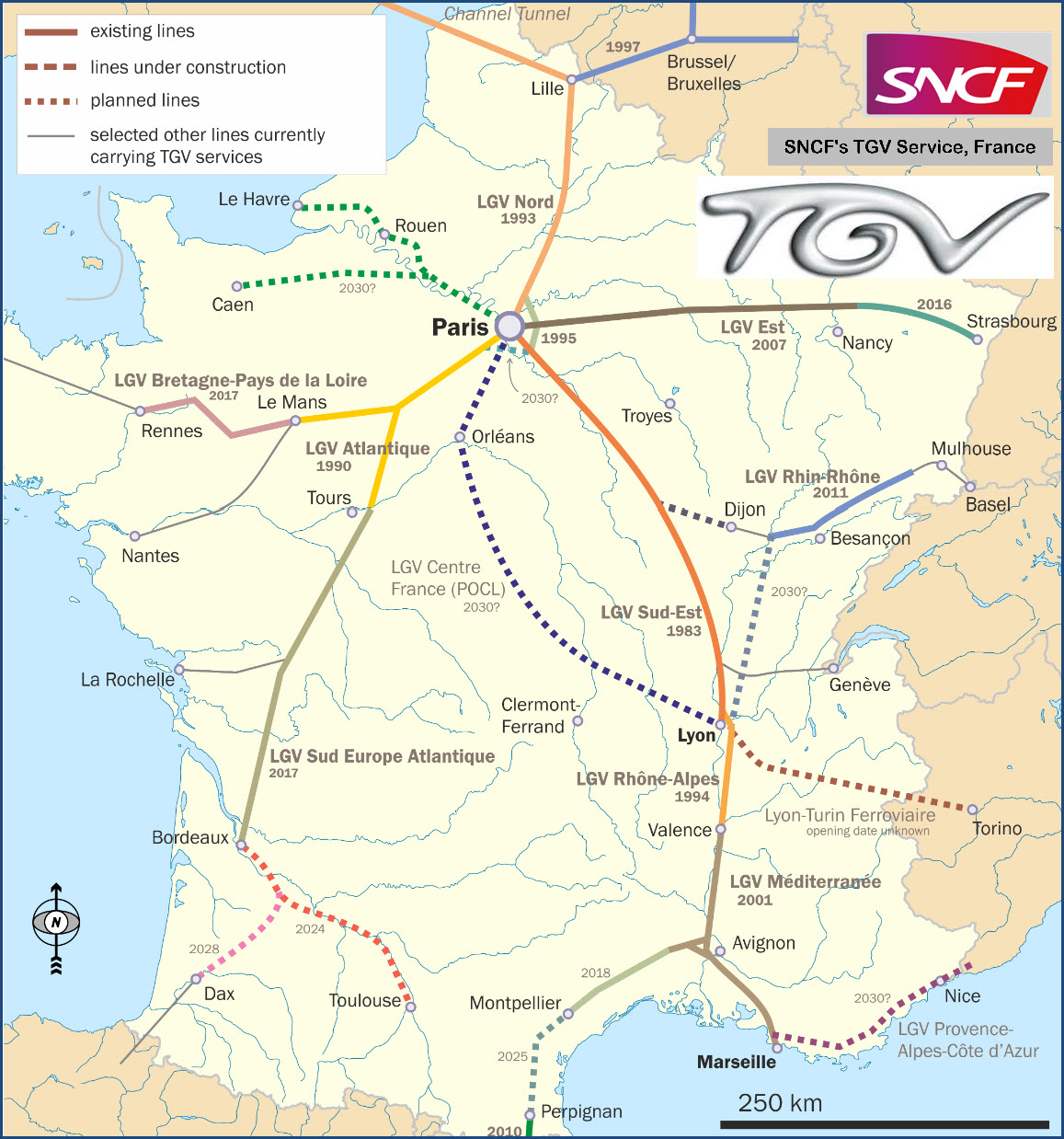
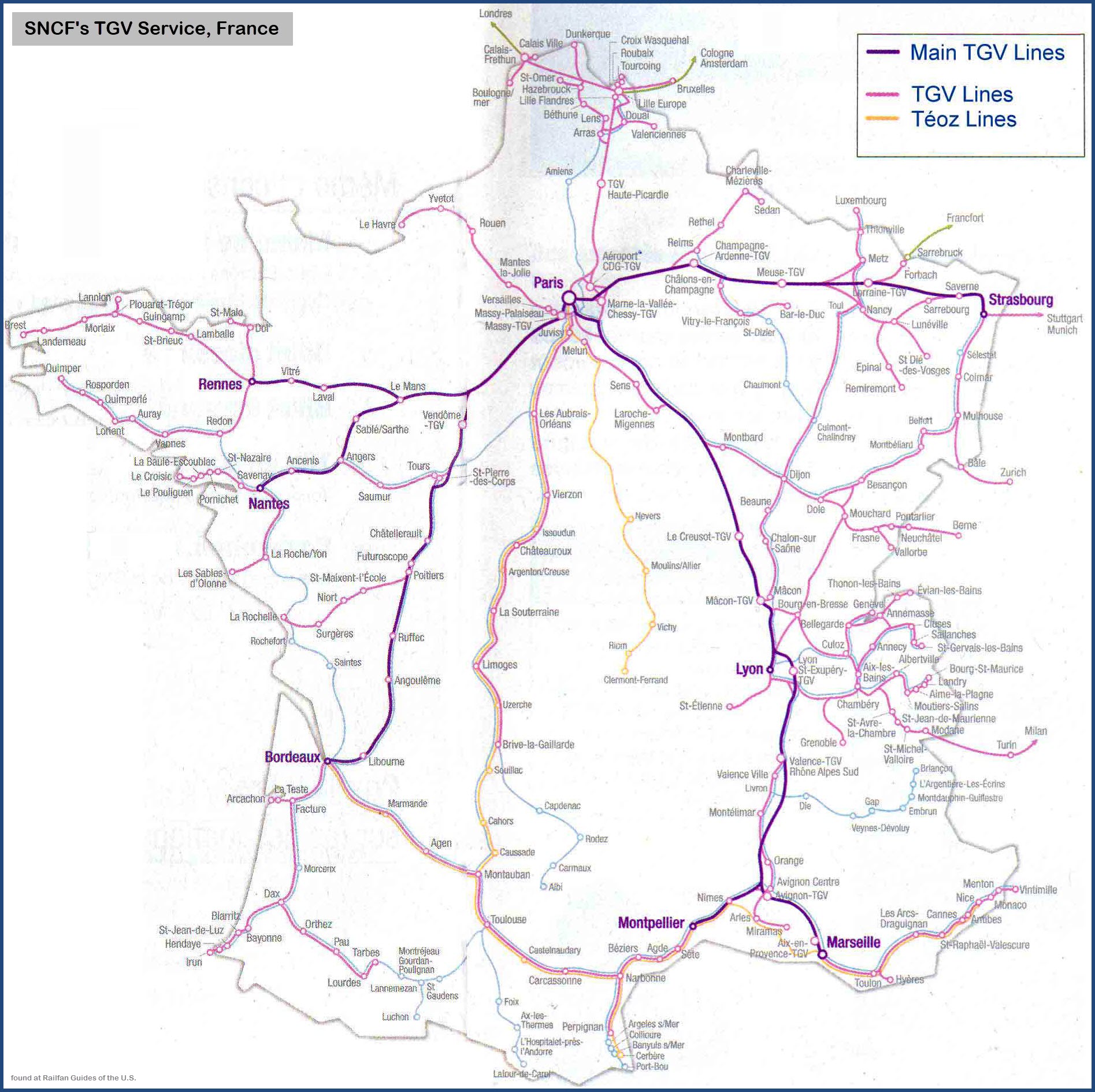
The two following info panels are related to the last TGV map....
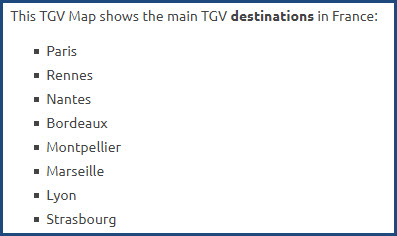
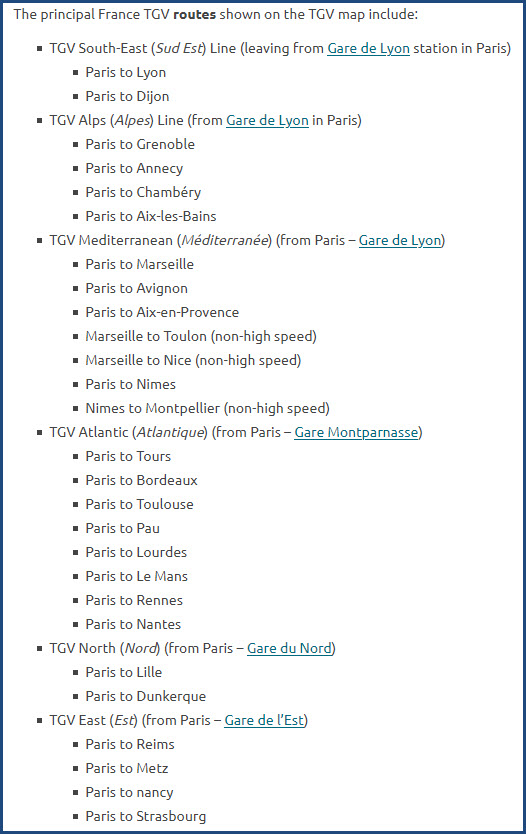
TGV Sud-Est (left), the first equipment used on the service and TGV 2N2 (right), the newest equipment used on the service, at Gare de Lyon station.
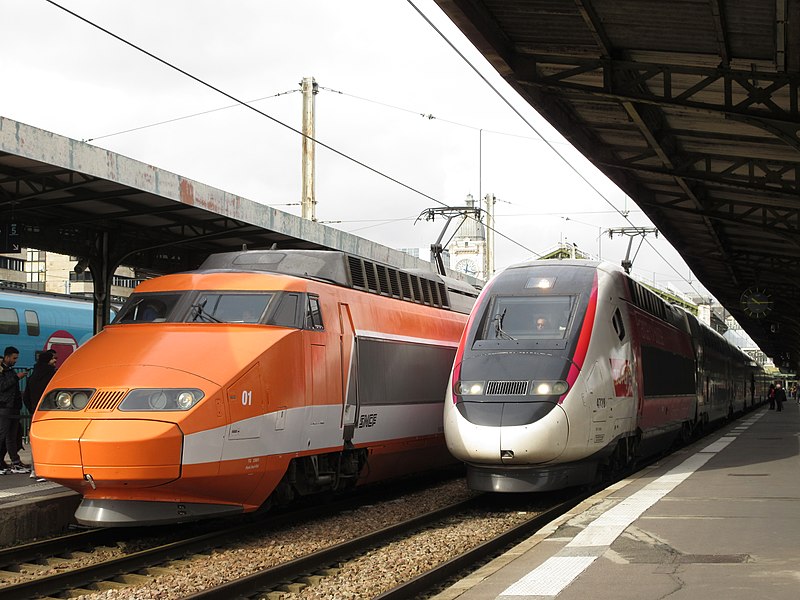 209, photo by S23725, via Wikipedia
209, photo by S23725, via Wikipedia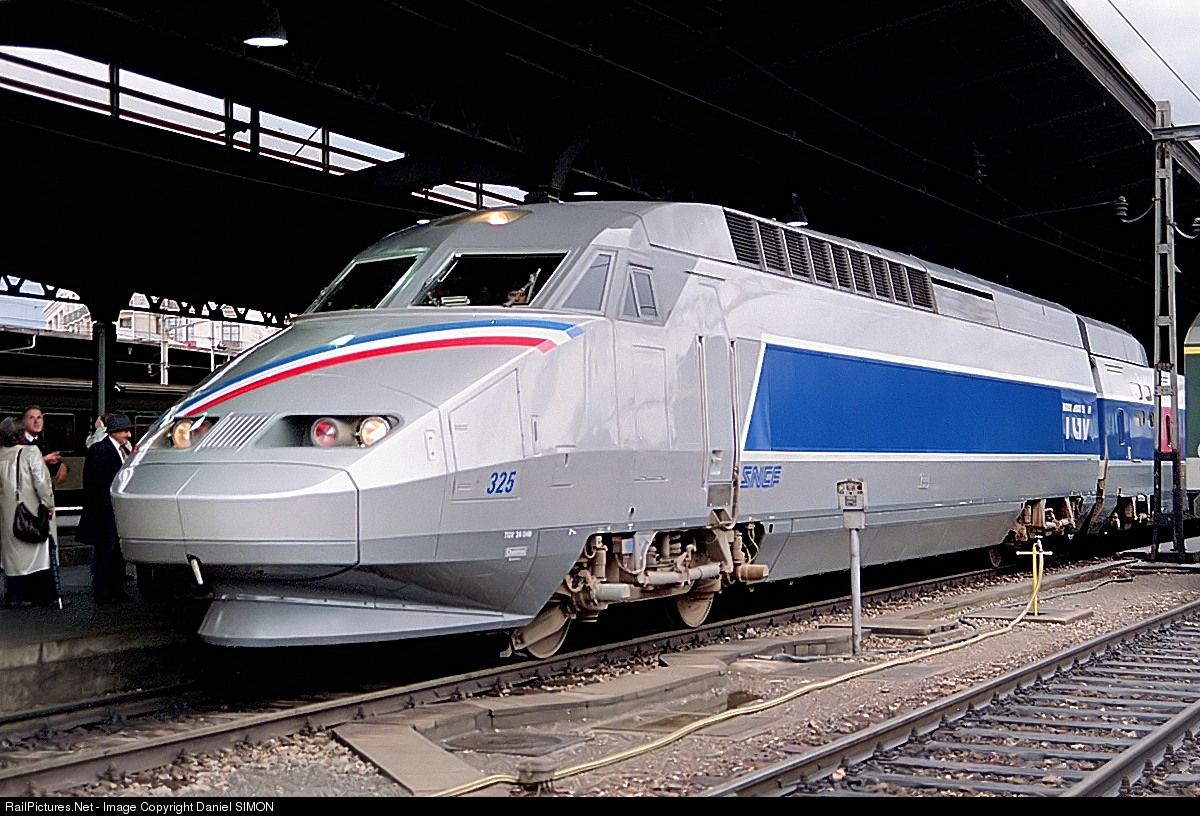
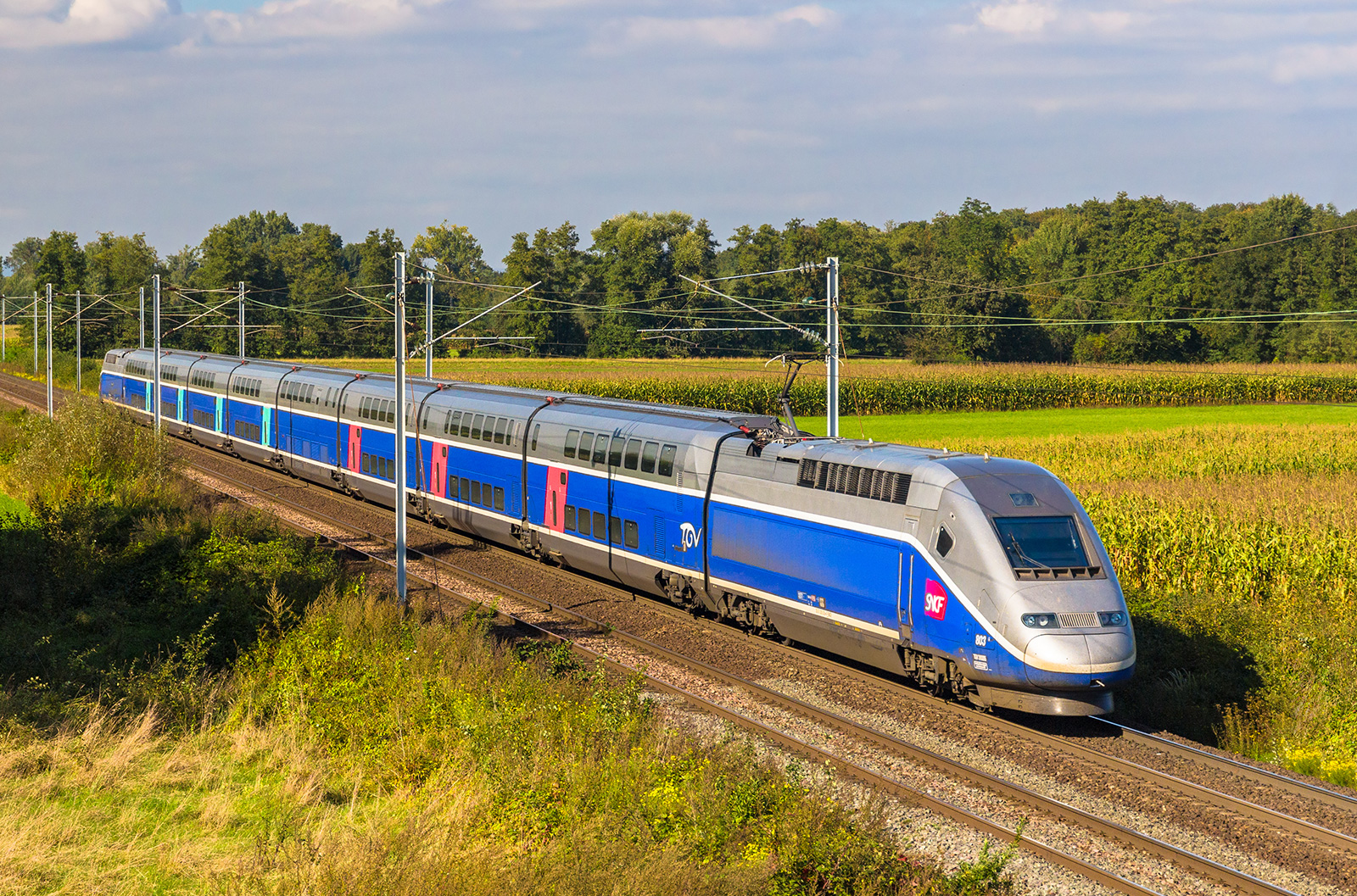

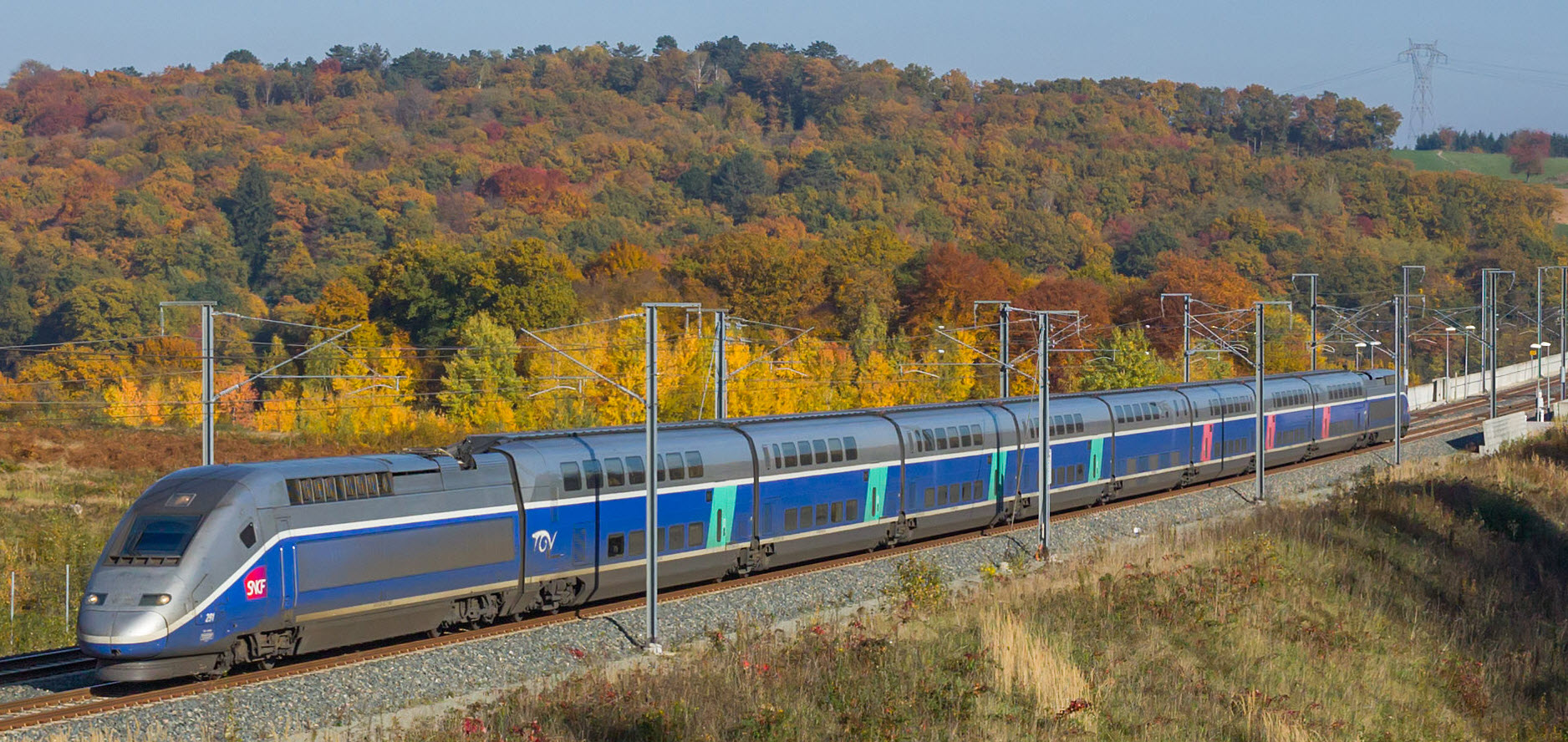 26OCT15, photo by Kabelleger / David Gubler
26OCT15, photo by Kabelleger / David GublerSNCF TGV Duplex 6841 Strasbourg - Montpellier has just accelerated to about 300 km/h on the new LGV Rhin-Rhône between Belfort and Dijon, pictured here near Héricourt, France.
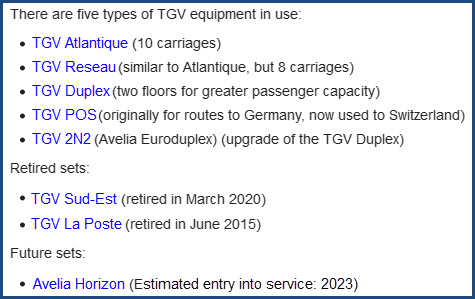
Generation 1
from Wikipedia: The SNCF TGV Sud-Est was a French high speed TGV train built by Alsthom and Francorail-MTE and operated by SNCF, the French national railway company. A total of 111 trainsets were built between 1978 and 1988 for the first TGV service in France between Paris and Lyon which opened in 1981. The trainsets were semi-permanently coupled, consisting of two power cars (locomotives) and eight articulated passenger carriages, ten in the case of the tri-voltage sets.
The first TGV train on the Paris-Geneva itinerary was commissioned in 1981. It had a seating capacity of 360 seats, and had a top speed of 270 km/h.
The trains were named after the Ligne à Grande Vitesse Sud-Est (literally: Southeast high-speed line) that they first operated on. They were also referred to as TGV-PSE, an abbreviation of Paris Sud-Est.
The TGV Sud-Est fleet was built between 1978 and 1988 and operated the first TGV service from Paris to Lyon in 1981. Formerly there were 107 passenger sets operating, of which nine were tri-current (25 kV 50-60 Hz AC - French lignes à grande vitesse, 1500 V DC - French lignes classiques, 15 kV 16⅔ Hz AC - Switzerland) and the rest bi-current (25 kV 50–60 Hz AC, 1500 V DC). There were also five, later seven, bi-current half-sets - TGV La Poste - without seats which carried mail for La Poste between Paris, Lyon and Avignon. These were painted in a distinctive yellow livery until they were phased out in 2015.
Each set was made up of two power cars and eight carriages (capacity 345 seats), including a powered bogie in each of the carriages adjacent to the power cars. They were 200 m (656 ft) long and 2.904 m (9 ft 6.3 in) wide. They weighed 385 tonnes (379 long tons; 424 short tons) with a power output of 6,450 kW (8,650 hp) under 25 kV.
When the trains were delivered they wore a distinctive orange, grey, and white livery. The last set to wear this livery was repainted in the silver livery similar to the TGV Atlantique sets in 2001. From 2012 trains were repainted in the new SNCF Carmillon livery. The TGV Sud-Est sets can be easily distinguished from the TGV-Atlantique and TGV-Reseau versions by the break in the roof just above the cabin windows.
Originally the sets were built to run at 270 km/h (168 mph) but most were upgraded to 300 km/h (186 mph) during their mid-life refurbishment in preparation for the opening of the LGV Méditerranée. The few sets which still have a maximum speed of 270 km/h (168 mph) operate on routes which have a comparatively short distance on the lignes à grande vitesse, such as those to Switzerland via Dijon. SNCF did not consider it financially worthwhile to upgrade their speed for a marginal reduction in journey time.
Nine sets were originally delivered as all first class. Set 88 was used as a test train for synchronous traction motors then subsequently rebuilt as a tri-voltage set and renumbered 118. Set 114 was sold to SBB. In 1995, Set 38, one of the all first class sets, was converted to an extra postal set in addition to the existing 5 half-sets
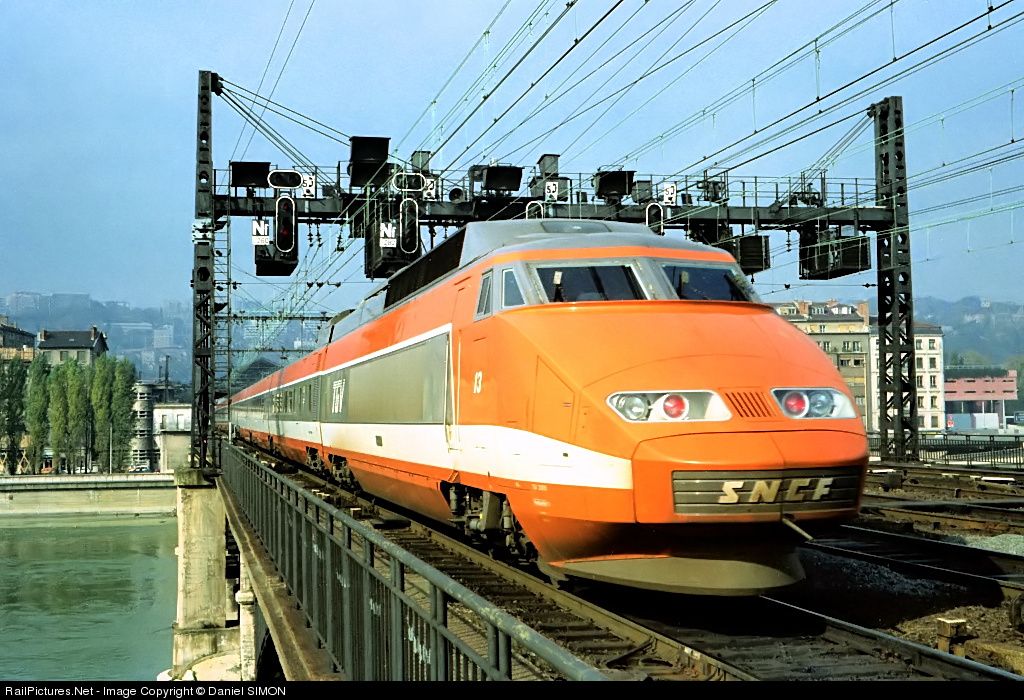 October 1981, photo by Daniel Simon
October 1981, photo by Daniel Simon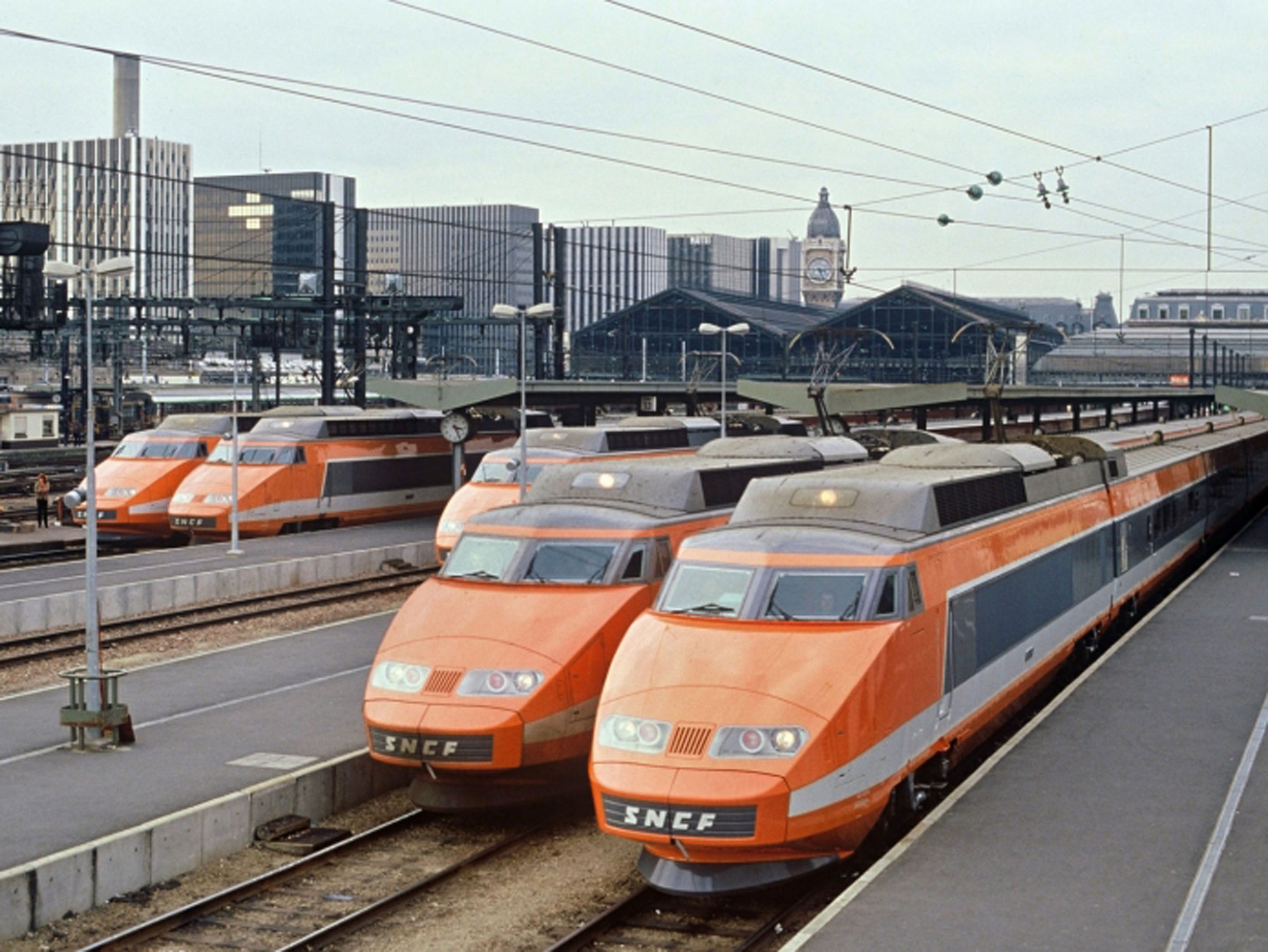
Generation 1 - Postal Version
https://en.wikipedia.org/wiki/SNCF_TGV_La_Poste
The TGV La Poste were dedicated trainsets for high-speed freight and mail transportation by French railway company SNCF on behalf of the French postal carrier La Poste. The top speed of this TGV Sud-Est derivate was 270 km/h (168 mph), making them the fastest freight trains in the world. They were taken out of service in 2015.
The trainsets were built by Alstom between 1978–1986. These TGV units are essentially TGV Sud-Est trainsets that are modified for transporting mail. Five half-trainsets were built, numbered 1-5. A further two, numbered 6 and 7, were converted from former TGV-SE trainset #38. Each half-trainset consisted of a power car and four intermediate-trailers.
In 2009, La Poste reduced services from 8 to 6 daily round trips. On 21 March 2012 a demonstration freight train ran to London-St Pancras, but there was no follow-up.
In mid-2015, La Poste ended TGV postal services, shifting mail services to swap bodies instead as part of a major logistics restructuring and expansion which the trainsets were not capable of handling. Additionally, the demand for fast overnight mail services has been decreasing in recent years. The final service was on 27 June 2015 between Cavaillon (Marseilles) and Charolais (Paris). La Poste originally was seeking a buyer for the fleet, however in December 2016 three trainsets were dismantled by SME (Société Métallurgique d'Épernay) leaving only a half spare trainset left.
Generation 2 - Atlantique
The 105-strong bi-current Atlantique fleet was built between 1988 and 1992 for the opening of the LGV Atlantique and entry into service began in 1989. They are 237.5 m (779 ft) long and 2.9 m (9.5 ft) wide. They weigh 444 tonnes, and are made up of two power cars and ten carriages with a capacity of 485 seats. They were built with a maximum speed of 300 km/h (190 mph) and 8,800 kW of power under 25 kV. The efficiency of the Atlantique with all seats filled has been calculated at 767 PMPG, though with a typical occupancy of 60% it is about 460 PMPG (a Toyota Prius with three passengers is 144 PMPG).
Modified unit 325 set the world speed record in 1990 on the LGV before its opening. Modifications such as improved aerodynamics, larger wheels and improved braking were made to enable speeds of over 500 km/h (310 mph). The set was reduced to two power cars and three carriages to improve the power-to-weight ratio, weighing 250 tonnes. Three carriages, including the bar carriage in the centre, is the minimum possible configuration because of the articulation.
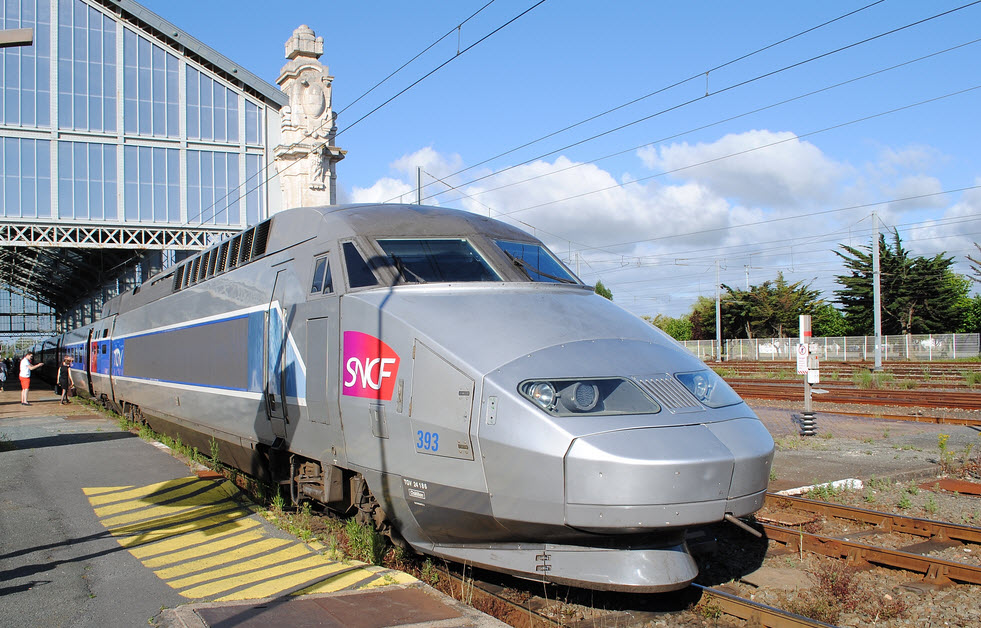 20JUN13, at La Rochelle, photo by Aviator12
20JUN13, at La Rochelle, photo by Aviator12Generation 3
The TGV Duplex is an electric TGV train operated by SNCF, commissioned in 2012. As its name implies, it features cars with two levels. Passengers circulate inside the train via the upper level, which also means travellers in the lower level can enjoy a more peaceful journey. This train meets the current international standards with regard to comfort, safety and access for people with reduced mobility. The train has 509 seats, and can reach a speed of 320 km/h.
Generation 4
The TGV POS was designed and built by Alstom for the French national rail company (SNCF) in the 2000s, originally ordered for the opening of the East European LGV, in order to provide new train services beyond Strasbourg towardsGermany and Switzerland. The POS 4402 train set the world speed record on 3 April 2007, reaching 574.8 km/h.
Generation 5
TGV
Future TGV Generations
SNCF and Alstom are investigating new technology that could be used for high-speed transport. The development of TGV trains is being pursued in the form of the Automotrice à grande vitesse (AGV) high-speed multiple unit with motors under each carriage. Investigations are being carried out with the aim of producing trains at the same cost as TGVs with the same safety standards. AGVs of the same length as TGVs could have up to 450 seats. The target speed is 360 kilometres per hour (220 mph). The prototype AGV was unveiled by Alstom on 5 February 2008.
Italian operator NTV is the first customer for the AGV, and became the first open-access high-speed rail operator in Europe, starting operation in 2011.
The design process of the next generation of TGVs began in 2016 when SNCF and Alstom signed an agreement to jointly develop the trainsets, with goals of reducing purchase and operating costs, as well as improved interior design.
The Avelia Horizon:
The design that emerged from the process was named Avelia Horizon, and in July 2018 SNCF ordered 100 trainsets with deliveries expected to begin in 2023. They are expected to cost €25 million per 8-car set.
Signals are already covered on my SNCF page: https://railfanguides.us/fr/sncf/#Signals_
https://en.wikipedia.org/wiki/French_railway_signalling
http://www.sh1.org/sncf/index.htm
http://www.railfaneurope.net/tgv/signals.html
Accident 5MAR2020, near Saverne
A French high-speed TGV train derailed early on Thursday after an embankment collapsed onto the tracks in eastern France, seriously injuring the driver and hurting 21 others. The train was heading to Paris at approximately 270 kilometres per hour (170mph) when the locomotive ran off the tracks near Ingenheim, about 30km (19 miles) northwest of Strasbourg.
https://www.usinenouvelle.com/article/en-direct-21-blesses-dans-le-deraillement-d-un-tgv-pres-de-saverne.N937104
https://www.aljazeera.com/news/2020/3/5/french-tgv-train-derails-near-strasbourg-22-hurt
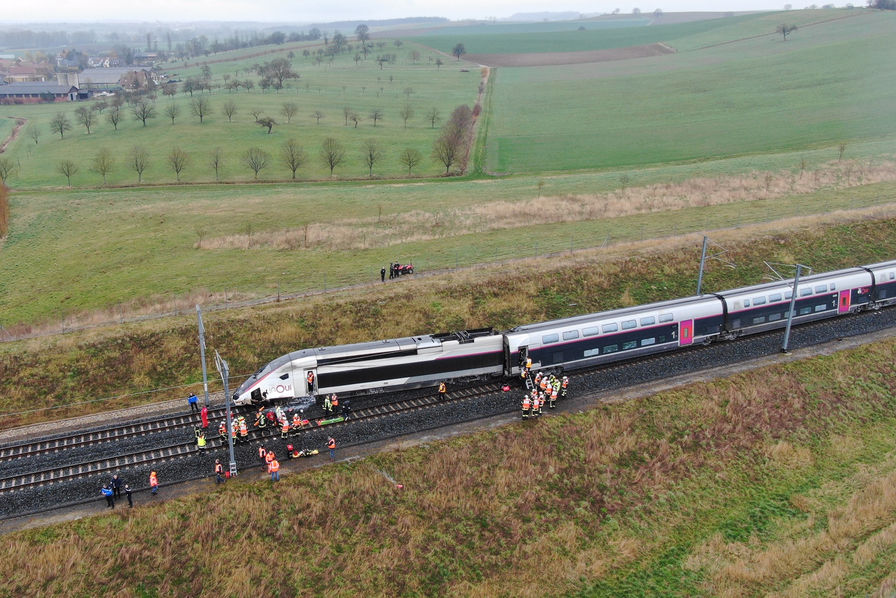
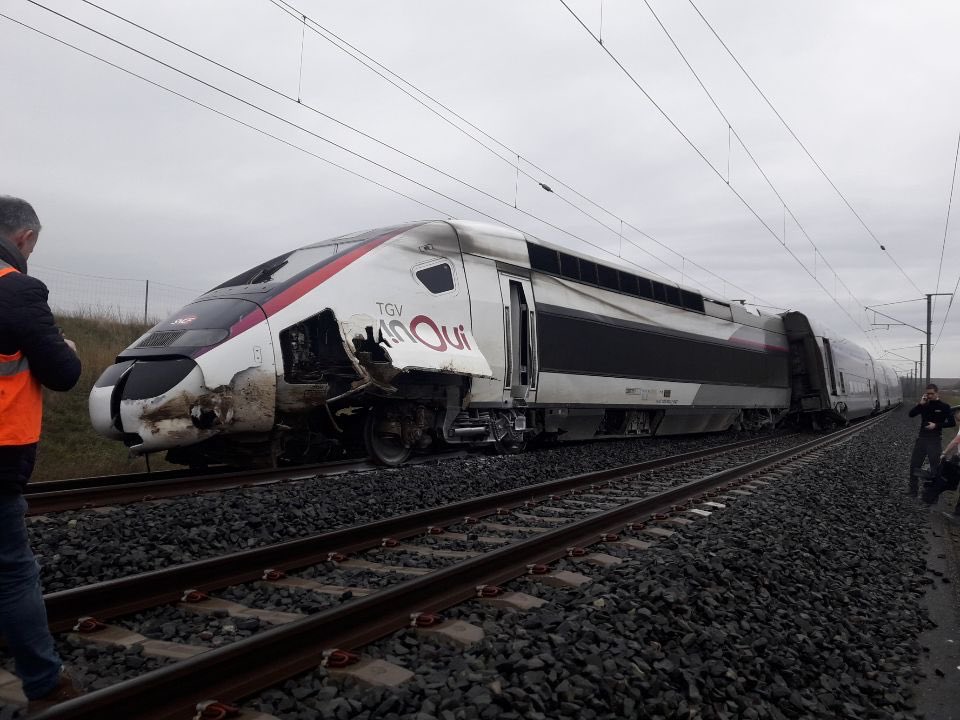
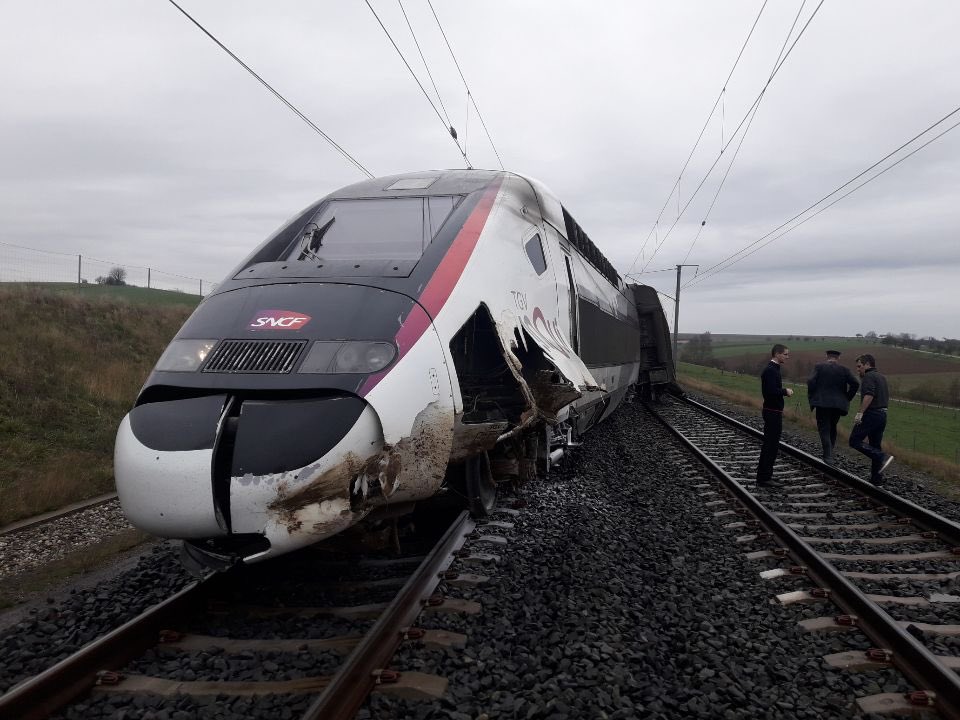
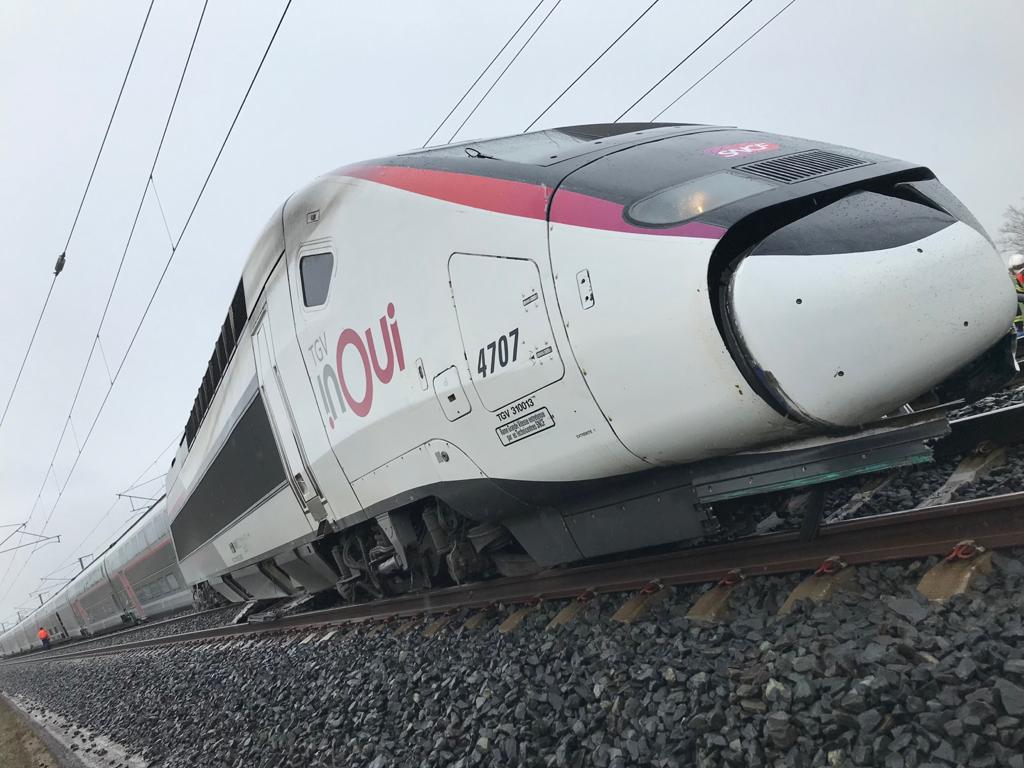
Disclaimers:
I love trains, and I love signals. I am not an expert. My webpages reflect what I find on the topic of the page. This is something I have fun with while trying to help others.
Please Note: Since the main focus of my two websites is railroad signals, the railfan guides are oriented towards the signal fan being able to locate them. For those of you into the modeling aspect of our hobby, my indexa page has a list of almost everything railroad oriented I can think of to provide you with at least a few pictures to help you detail your pike.
If this is a railfan page, every effort has been made to make sure that the information contained on this map and in this railfan guide is correct. Once in a while, an error may creep in :-)
My philosophy: Pictures and maps are worth a thousand words, especially for railfanning. Text descriptions only get you so far, especially if you get lost or disoriented. Take along good maps.... a GPS is OK to get somewhere, but maps are still better if you get lost! I belong to AAA, which allows you to get local maps for free when you visit the local branches. ADC puts out a nice series of county maps for the Washington DC area, but their state maps do not have the railroads on them. If you can find em, I like the National Geographic map book of the U.S..... good, clear, and concise graphics, and they do a really good job of showing you where tourist type attractions are, although they too lack the railroads. Other notes about specific areas will show up on that page if known.
Aerial shots were taken from either Google or Bing Maps as noted. Screen captures are made with Snagit, a Techsmith product... a great tool if you have never used it!
By the way, floobydust is a term I picked up 30-40 years ago from a National Semiconductor data book, and means miscellaneous and/or other stuff.
Pictures and additional information is always needed if anyone feels inclined to take 'em, send 'em, and share 'em, or if you have something to add or correct.... credit is always given! Please be NICE!!! Contact info is here
Beware: If used as a source, ANYTHING from Wikipedia must be treated as being possibly inaccurate, wrong, or not true.
RAILFAN GUIDES HOME
RAILROAD SIGNALS HOME
NEW MAR17/2021
Last Modified 19-Mar-2021